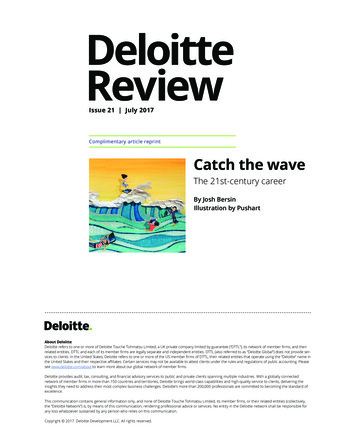
Transcription
Issue 21 July 2017Complimentary article reprintCatch the waveThe 21st-century careerBy Josh BersinIllustration by PushartAbout DeloitteDeloitte refers to one or more of Deloitte Touche Tohmatsu Limited, a UK private company limited by guarantee (“DTTL”), its network of member firms, and theirrelated entities. DTTL and each of its member firms are legally separate and independent entities. DTTL (also referred to as “Deloitte Global”) does not provide services to clients. In the United States, Deloitte refers to one or more of the US member firms of DTTL, their related entities that operate using the “Deloitte” name inthe United States and their respective affiliates. Certain services may not be available to attest clients under the rules and regulations of public accounting. Pleasesee www.deloitte.com/about to learn more about our global network of member firms.Deloitte provides audit, tax, consulting, and financial advisory services to public and private clients spanning multiple industries. With a globally connectednetwork of member firms in more than 150 countries and territories, Deloitte brings world-class capabilities and high-quality service to clients, delivering theinsights they need to address their most complex business challenges. Deloitte’s more than 200,000 professionals are committed to becoming the standard ofexcellence.This communication contains general information only, and none of Deloitte Touche Tohmatsu Limited, its member firms, or their related entities (collectively,the “Deloitte Network”) is, by means of this communication, rendering professional advice or services. No entity in the Deloitte network shall be responsible forany loss whatsoever sustained by any person who relies on this communication.Copyright 2017. Deloitte Development LLC. All rights reserved.
62Catch the view.com
Catch the waveBy Josh BersinIllustration by Pushartwww.deloittereview.com63
64Catch the waveNEW MODELS FOR ANEW WORLDOFFERINGleadership). Young,employees anewly hired employees often have skills not found in expe-rewarding career usedrienced hires, leaving many older peopleto be easy: You’d hire a brightto work for young leaders. And the rapidyoung person out of college,plug him into an entry-levelpace of technology makes many jobs,role, and then watch himcrafts, and skills go out of date inclimb the corporate ladder overonly a few years.2the years as he progressed towardretirement. The company could plan forthis continuous process—hire people based ontheir degrees, help them develop slowly andsteadily, and expect some to become leaders, some to become specialists, and someto plateau.The training department used to offera stable and well-architected career (I spentmy entire first year at IBM as a “trainee,” witha 10-year career path clearly laid out). Today,many training departments are struggling tokeep up, often pointing us to online coursesand programs, telling us that it’s our job toToday this model is being shattered. As re-“reskill ourselves.” And while they try to givesearch suggests, and as I’ve seen in my own ca-us what we need to stay ahead, research showsreer, the days of a steady, stable career are over.that they are also falling behind: EmployeesOrganizations have become flatter and lessrate their L&D departments a dismal -8 in netladder-like, making upward progression lesspromoter score, lower than almost any prod-common (often replaced by team or projectuct in the consumer landscape.31www.deloittereview.com
Catch the waveAs technology evolves apace and more of us A career represents our expertise, ourwork part-time, these trends are only accel-profession, and ultimately our iden-erating. LinkedIn co-founder Reid Hoffmantity. It defines who we are and what webelieves that careers are now simply “toursdo. This form of self-identity makes chang-of duty,”4 prompting companies to design or-ing careers dauntingly difficult: What if weganizations that assume people will only stayswitch careers and fail? Then who are we?a few years. And data bears this out: 58 percent of companies believe their new employees A career is something that buildswill stick around less than 10 years.5 (LinkedInover time and endures. It gives us theresearch shows that, on average, new degree-opportunity to progress, advance, and con-holders have twice as many jobs in their firsttinuously feel proud. When we are asked tofive post-college years now as they did in thechange our career or path, what happensmid-1980s.6)to all we have learned? Do we throw it allBut hold on. The world of careers doesn’t haveto be so difficult and unforgiving. Organizations can adapt their career strategies and helppeople learn faster and continue to stay engaged. It just takes a rethinking of the problem,and a need to be aware of how jobs, careers,and skills are rapidly changing.The bottom-line question is this: How can organizations build career models that encourage continuous learning, improve individualmobility, and foster a growth mind-set in everyemployee, year after year? This is the opportunity for today; companies that figure this outwill outperform, out-innovate, and out-executetheir peers.7The changing nature of careersLet’s examine what a “career” really is. The traditional idea of a career has three components:away? Or can we carry it forward? A career gives us financial and psychological rewards. It makes life meaningful,gives us purpose, and pays us enough to livewell. What happens if our career suddenlybecomes less valuable, even if we still enjoyit? Should we continue to make less moneyor jump to a new path?The changing world of work has disrupted allthree elements: expertise, duration, and rewards. And as scary as this may be for employees trying to stay ahead, it’s equally disruptivefor employers who must try to hire and develop the workforce of today, tomorrow, and fiveyears from now.Expertise has an ever-shorter shelf lifeIt used to be that only certain types of jobs—think of computer programmers and IT trou-www.deloittereview.com65
66Catch the waveThe changing world of work has disrupted all three elements of acareer: expertise, duration, and rewards.bleshooters—needed constant training androte work of lawyers,10 simplifying the work ofupskilling. Now, all of us are expected to con-doctors,11 and changing skilled jobs from trucktinuously learn new skills, new tools, and newdriver to financial analyst. As we describe later,systems. Just as COBOL programmers had toit’s important for each one of us to learn newlearn C and Java, administrative assistantstools, adapt our skills, and become more multi-have switched from typewriters and dictationdisciplinary in our expertise.machines to PCs and voice memos, assemblyline workers have had to learn to operate robots, and designers have moved from sketchpads and clay models to touchscreens and 3Dprinting.What this means to employers is simple: Youremployees are constantly feeling a need to“keep up.” Millennials, for example, rate “learning and development opportunities” as thenumber-one driver of a “good job.”12 Manag-In technical fields, there is constant pressureers should give people time, opportunity, andto master new technologies or risk becomingcoaching to progress; if you don’t, people ofteninstantly obsolete. One of our clients anony-just look elsewhere.mously surveyed its IT department about whatskills people wanted to learn, and more than80 percent said they were desperate to learntools such as AngularJS (a new open-sourceprogramming environment for mobile apps),even though the company was not yet using thetechnology.8The idea of a single, long-lasting careeris becoming a thing of the pastRemember the 30-year “lifelong career” thatcompanies promoted during the last century?Well, today only 19 percent of companies stillhave traditional functional career models.13Why have so many organizations let multi-de-Today even experts find themselves disrupted.Few professions today are hotter than that of asoftware engineer . . . and yet many foresee automation taking over the work of coding in thenear future.9 Artificial intelligence is doing thewww.deloittereview.comcade career models fade away?First, business structures have changed. Theiconic industrial companies of the early 1900s(steel, automobile, energy, and manufacturing)
Catch the wavehave outsourced to smaller firms many of theirexcellent these employers might be, their pri-business processes and sales channels, as wellmary workforce is mid-level labor—service andas various parts of their value chain. The resultdelivery roles that neither pay as well nor offerhas been a steady increase in innovation andthe long-term “career professional” advance-profitability, but a dramatic decay in the secu-ment that large companies once routinely of-rity of a “company man” career.fered.14When I entered the workforce in 1978 as a freshThis has created opportunities for some work-engineering graduate from Cornell, I remem-ers but has left others behind their parents atber dozens of big companies looking for youngthe same age. One study found that workersengineers to train for lifetime careers, each of-who entered the labor force in the 1980s andfering job rotation, heavy amounts of training,1990s were more than twice as likely to stay inand seemingly lifelong employment. I actuallylow-wage, dead-end jobs over the next decadejoined one of these companies—IBM—only tocompared with similar employees who joinedfind my career options altered entirely whenthe workforce in the late 1960s and early 1970smanagement launched a massive turnaround.(at the high point of the corporate economy).19(I decided to move to a smaller, faster-growingPart of the reason: Big corporations have out-company.)sourced many specialized (and highly paidSimilar stories can be told in automobile, manufacturing, financial services, retail, hospital-tasks), which can make it harder to “move up”in socioeconomic status.ity, and many other industries. In 1970, the 25Driven by opportunism (why stay at a com-biggest American corporations employed thepany where advancement opportunities areequivalent of over 10 percent of the private la-limited?) and necessity (what else can you dobor force. Today, many of the largest US em-when your job is outsourced?), the practiceployers by number are retailers, and the retailof switching jobs and companies grew moreindustry alone accounts for more than 10 per-common, until job-hopping became the norm.cent of US employment.17 In the current eco-People my age, for instance, typically workednomic recovery, the fastest-growing segmentfor four to five companies during their workingof work has been health care, including smalllifetime. Today, a college graduate may workand large hospitals, eldercare providers, andfor as many companies in their first 10 yearsvarious types of personal-care work.18 Howeverafter graduation.201516www.deloittereview.com67
68Catch the waveTHE LONGEVITY DIVIDEND: PLANNING FOR A LONGER HORIZONThere’s a happy reason for some of the anxiety about unsettled career paths: Human beings—inmost countries, that is—are living longer than ever.21 While babies born in 1900 rarely lived pastthe age of 50, in most countries the life expectancy of babies born today exceeds 70; researchsuggests that Millennials will reach an average age of 90.22Governments, anticipating a flood of retirement benefit payouts, are responding by looking topush back workers’ standard retirement age.23 And indeed, with unions in decline and much morerapid job mobility, fewer workers—even in labor-intensive roles—are able to retire after 30 years,forcing people to work longer.24 This means that young people should expect careers spanninghalf a century or longer; schools and employers should help prepare and guide people throughworking lives in which they learn, work, learn, work, and cycle through career stages many times.I recently met with the senior executive team of a revered, century-old manufacturer that enjoystremendously high employee retention. As we discussed these issues, the executives decidedthat they were going to redesign their career strategy around employees working longer—activelyencouraging and supporting workers’ efforts to continuously reinvent themselves.25SURFING FROM WAVE TO WAVEONE way to think about careers todayis to consider yourself a surfer: Wecatch a good wave early in our life;as it crests and falls, we need to look for thenext wave. Bersin by Deloitte’s research and anexamination of data from labor market analytics firm Burning Glass Technologies26 confirmthat while many technical skills are in highdemand, they decay in value as more peopleacquire proficiency in those skills. Graphic designers, for example, are far less valuable thanwhen the Internet was invented: Experts canstill earn a good living, but organizations needIn certain emerging fields, of course, expertiseis in high demand, driving commensurate rewards. Organizations need technical peopleproficient in Hadoop and other big data solutions, for example, as well as experts in hotfields such as cybersecurity. And they pay topdollar for skilled people in these areas. But overthe coming years, as the supply of expertise inthese areas grows, the fields themselves shift inunforeseen ways (Hadoop experts become experts in other technologies, for example). Theexperts, then, must look to “surf” to the nextwave, unless they’re content to settle for steadily declining financial returns.many fewer experts, since in a sense we haveI suggest that each of us should think about ourall become designers.career as a series of waves from post-educationwww.deloittereview.com
Catch the waveto pre-retirement: We’ll catch a wave and ridetors, and HR teams should realize this shift andit until it crests, and then, as it calms on themake training and remedial education avail-beach, we paddle out and catch the next one. Inable to everyone in the company.each new wave, we gain new skills and new experiences, retraining and educating ourselvesalong the way.That said, STEM no longer tells the wholestory of skills in the 21st century. Tasks basedon math, science, and engineering are vulnerable to automation, so they should be comple-Soft skills growing in value: From STEMto STEAMmented with soft skills and other strengths asWhile many companies have outsourced spe-well. In the 1800s, machinists and metalwork-cialized tasks over the years, big companies stillers were the computer scientists of today; asneed myriad technical and professional talent.automated manufacturing grew and moreOur research with Burning Glass shows thatpowerful machines were invented, these “met-skills in math, statistics, project management,al-bending” careers often turned into careersand logical thinking are now prerequisites fordeveloping, operating, and fixing machines. Ifmost positions (even those in marketing, fi-you learned how to be a draftsman in the 1970s,nance, and HR). The problem, again: Suchyou likely watched your profession taken overtechnical expertise may soon be outsourced,by computer-aided-design software in theautomated, or commoditized by youth, giving1980s and 1990s. And if you’re up to date onway to new technical roles of which no one hasstatistics and math, you may increasingly findyet dreamed. Already, thousands of people areyourself stretching to do programming, analy-working as “robotic trainers,”27 analyzing whatsis, and interpretation of data, since softwareself-driving cars do and working to make themprograms do many of the computations.smarter; it’s a good bet they’ll be doing something different a decade from now.While the core need for technical skills remainsstrong, another theme has entered the job mar-Today, anyone who wants a shot at a well-com-ket: the need for people with skills in commu-pensated position should consider developingnication, interpretation, design, and syntheticskills in math, statistics, and logical thinking;thinking. In a way, we can think of these as thecomfort with data is increasingly essential. It’sarts, hence the evolution of education fromsafe to say that anyone who lacks a basic un-STEM to STEAM.derstanding of science, technology, engineering, and math—the STEM fields—will likelyfind limited career options. Managers, men-What does it mean to add arts to STEM? It isn’tas simple as taking a few courses in art history or reading Chaucer. The jobs of the future,www.deloittereview.com69
70Catch the wavedriven by the increasing use of technology tak-to sense the best way to assess and defuse theing over rote tasks, require social skills comple-situation, but a well-trained, empathetic tellermenting more technical abilities.can—and that’s what makes her invaluable toThink about the job of a salesperson, bank teller,the bank.nurse or caregiver, or business leader—all in-Consider figure 1, developed by Harvard re-demand jobs that draw upon empathy, socialsearcher David Deming,28 showing that someskills, communication, and synthetic thinking.of the best jobs in the future—those in green—When an angry bank customer strides up to aare those that draw upon both technical andteller window, an AI program lacks the toolssocial skills. Yes, developers can program com-WILL YOU STILL HIRE ME TOMORROW?In early 2016, our colleagues at Deloitte UK looked at Oxford University’s noted study predictingwhich jobs would disappear over the next 20 years. They mapped these jobs against the O*NETjob skills required in both the “disappearing jobs” and the “growing jobs,” identifying a set of 40 “essentially human skills” that are becoming ever more important in the workforce.29 The findingsclearly point in this direction:Brains over brawn: In absolute terms, knowledge of specialist STEM subjects is 40 percentmore important than the physical abilities of strength, endurance, flexibility, or the ability tomanipulate objects.Social and cognitive skills: A 10 percent increase in cognitive abilities contributes to a 12 percentincrease in median hourly earnings.STEM and STEAM continue to grow: By 2039, math and science knowledge is expected toincrease in importance by 8 percent, leading to approximately 4.5 million new STEM-enabled jobsto be created globally, including engineers, scientists, IT and digital professionals, economists,statisticians, and teachers.This study, one of the largest of its kind, maps skills into various categories across all the “newjobs” and “retiring jobs” to identify what we call the “essential skills” for the future. As this researchsuggests, skills in communication, critical thinking, visual identity, and reasoning will likely becomeeven more important in the future. For job seekers or career surfers, it is a reminder that ourrelationship, communication, and thinking skills are critical.www.deloittereview.com
Catch the waveFigure 1. Which jobs require social skills?Change in share of jobs, 1980–2012Grew100About the sameLawyers and judgesFellFinancial managersSocial egistered nurses75DesignersComputer systems analystsand computer scientistsSocial skill percentileLicensed practical nursesAccountants and auditorsDentistsNurses and nurse’s aidesHealth technologists and techniciansDental assistants50Secretaries andadministrative assistantsTruckdriversEngineering and science techniciansChemical techniciansGeneral office clerksBank tellersMathematicians and statisticiansAgriculturaland foodscientistsRecords erations and systems researchers and analystsPolice and detectivesChild care workersEconomistsManagement analystsBookkeeping andaccounting andauditing clerksElectriciansIndustrial machinery repairersCarpentersBiological techniciansAssemblers of electrical equipmentLaborersWeldersStatisticalclerksMachine operators0Tool and die makers and die setters0255075100Math skill percentileSource: David Deming, Harvard University.Deloitte University Press dupress.deloitte.comwww.deloittereview.com71
72Catch the waveputers to take on rote and information-based Organizations are driving a huge increase intasks, but machines are not yet much good atdemand for analytic roles. Jobs called “datalistening, empathizing, communicating, andscientist” or “analyst” are growing rapidly,convincing.with the overall number of data science andTHE EMERGENCE OF HYBRID JOBSTanalytics jobs expected to reach 2.7 millionannual postings globally by 2020. TheseHE research I’ve done (including talkingjobs are growing in all industries and all de-with academics, economists, and hiringveloped economies, with particularly highmanagers) indicates that wage increasesgrowth in the United Kingdom, Canada,are primarily going to two types of jobs. First,and Australia.as one might expect, are the hot “technicalroles” where skills are (currently) scarce. Sec- These jobs are not simply degreed posi-ond, however, are what we might call “hybridtions—they are jobs that combine math,jobs”—jobs that create whole new job catego-statistics, critical thinking, and industry ex-ries by mashing up disciplines.30 These “renais-pertise, not just skills in data management.sance jobs” are those that combine technicalData scientists with industry expertise andexpertise (in one or more domains) with exper-experience, for example, command almosttise in design, project management, or client50 percent higher pay than those with pureand customer interaction. They might be titledtechnical skills.“experience architect” or “IoT engineer” or “userexperience designer” or “security consultant,” These new positions are creating whatand they typically involve knowledge of a tech-Burning Glass calls a “new genome” for jobs,nical domain, problem-solving capability, proj-combining skills from previous roles into aect management, and often industry expertise.new role. Whether called “data analysts” orEven workers in highly technical fields are in-“digital marketing managers” or “HR andcreasingly expected to bring softer skills to thepeople analytics leaders,” they combinetable. A 2017 study by Burning Glass, Busi-technical skills with domain and systemsness–Higher Education Forum, and IBM ana-expertise in the chosen domain.lyzed new jobs being created in data scienceand digital marketing and found several im- These roles now require new types of softskills. Figure 2 shows the types of expertiseportant things:31for which employers are looking in dataanalysis positions: research skills, writingwww.deloittereview.com
Catch the waveskills, and problem-solving skills, alongable to their employers. This effect, the “ma-with teamwork and creativity. These arechine augmentation of work,” can be a positiverarely developed through coursework inthing for organizations as well as employees—math or statistics—they’re more likely tobut only if people take the time to learn how toemerge from a background in English, his-use the new tools.tory, art, or business. Hence the shift fromSTEM to STEAM.Since the Industrial Revolution, workers havehad to regularly adjust to working with newI remember all too well the early days of themachines and systems, but the fast-paced in-spreadsheet (Multiplan, then Lotus 1-2-3, thenformation age makes the hybridization of jobs aExcel) and the fears that these tools wouldnever-ending process. Salespeople are now ex-make financial analysts obsolete. Somethingpected to use technological tools such as Sales-quite different happened: Yes, analysts had toforce and task management systems; they mustlearn these tools in order to survive, but theyunderstand how to negotiate and forecast, andthen became “super analysts” far more valu-over time they will likely have to learn how toFigure 2. Data jobs require more soft skillsPercentage of posts requesting soft ng22%22%Writing27%10%Research0%5%10%All jobs29%15%20%25%30%Data science and analysis jobsSource: Matt Sigelman, “By the numbers: The job market for data science and analytics,” Burning Glass Technologies,February 10, 2017.Deloitte University Press dupress.deloitte.comwww.deloittereview.com73
74Catch the waveFigure 3. The evolution of learning and development has been blindingly 1020172020E-learningand arningIntelligentlearningCourse catalogOnline universityLearning pathCareer trackVideo, self-authoredMobile, YouTubeMicro-learningReal-time videoCourses everywhereInstructional designKirkpatrickBlended learningSocial learning70-20-10 taxonomiesDesign thinkingLearning experienceSelf-studyOnline learningCareer-focusedLots of topicsLearning on demandEmbedded learningEveryone, all the time,everywhereLMS ase-learning platformLMS as talentplatformLMS as experienceplatformLMS invisibleData-driven, e: Bersin by Deloitte, Deloitte Consulting LLP, High-Impact Learning Organization research, 2017.Deloitte University Press dupress.deloitte.comtake signals from AI-based tools. (Salesforce’snew US “edtech” companies and ventures.33new product Einstein is designed to smartlyAs technologies such as smartphones, embed-recommend whom to call first. ) Managersded video, and YouTube have put high-fidelitywill likely be increasingly wary of profession-learning at people’s fingertips, the global mar-als who routinely resist learning new tools untilketplace for education, professional skills de-they have no choice.velopment, and corporate training has grown32What is the future role of learning?to over 400 billion. Individuals can go onlineto knowledge-sharing sites such as Udemy,If we accept the fact that people need to contin-courseware sites such as LinkedIn Learning,uously learn and reskill, how do we make thator technical education sites such as Pluralsight,happen? Do we encourage everyone to go backSkill-soft, and General Assembly and find low-to school every few years and earn another de-cost courses, lessons, and expert education.gree? Not necessarily.Indeed, many corporate HR teams have foundOver the past decade, the training and learn-the rapid shift in learning options (figure 3)ing industry has exploded: In 2015 and 2016somewhat disruptive; executives regularly ac-alone, investors put more than 1 billion intoknowledge to us that their internal learningwww.deloittereview.com
Catch the waveand development (L&D) programs lag behindthe consumer marketplace. In fact, in our mostrecent High-Impact Learning Organizationsurvey, employees gave their training departments a low -8 net promoter score, complaining of outdated learning management systemsand legacy content.34SOLUTIONS: THE ROLE OF BUSINESSAS hard as we may try, nothing canreverse the trends toward longer lifetimes, shorter tenure, and the relent-less pressure to master new technologies. Butorganizations can make it easier by adoptingan active program to support people’s reskill-All of these changes have made L&D a vital parting, re-education, and career development.of companies’ employment brand and employ-Our research on this topic shows that it has be-ee experience, and we urge executives to investcome a top priority: The 2017 Deloitte Globalin this area. Indeed, innovative companiesHuman Capital Trends report rated L&D thesuch as GE, Visa, and IBM are building inter-second-biggest issue among business and HRnal massive open online courses (MOOCs) andleaders, up from fifth only a year ago, and in-entire networks of internally developed con-dicated that 83 percent of companies are re-tent, enabling employees to shop for any train-engineering their career programs.ing they need, including peer-authored materi-Many organizations, though, have far to go.al.35 Since L&D has become the fastest-growingSome of the leading practices in this area in-segment of the HR technology market,clude:36wecan expect many companies to replace and upgrade their internal learning systems over thenext five years.As a career development tool, the availability ofconsumer and corporate learning is a godsend:From their desktops, employees can attendMOOCs from firms such as Udacity, Coursera, NovoEd, and edX and take courses fromacademic and professional experts in a widerange of technical, managerial, and personalskills topics. Increasingly, too, training firms Opening up learning and content to employees at all levels at no cost (Bank of Americanow offers a prepaid “credit card” for employees to skill themselves, for example)37 Investing in a large library of training content for employees to use (IBM and GE license courses and content from dozens ofcompanies and have negotiated pay-peruse contracts)38offer program certificates for those completingcourses, indicating new competencies.www.deloittereview.com75
76Catch the waveForward-thinking companies today offer career-planning tools,actively post jobs internally, and encourage and support internalhires and transfers. Creating a culture of learning among man- Investing in a chief learning officer with anagement: rewarding managers for develop-established corporate budget to watch overing their people, re-engineering the perfor-and shepherd learning solutions in all themance management process to focus onvarious business units and functional areasdevelopment, giving managers incentivesfor hiring internal candidates versus exter- Investing in onboarding programs andnal candidates (AT&T has focused its entiretransition-management programs that helpcorporate culture on the continuous reskill-people move into new roles (Royal Banking of its employees)39of Canada has developed a new-hire program for branch bankers that lasts an entire Creating career paths and self-assessmenttools to help employees find new jobs andyear, designed for both new employees andtransfers)41new career paths within the company (IBM Workin
68 Catch the wave SURFING FROM WAVE TO WAVE O NE way to think about careers today is to consider yourself a surfer: We catch a good wave early in our life; as it crests and falls, we need to look for the next wave. Bersin by Deloitte's research and an examination of data from labor market analyt-ics firm Burning Glass Technologies26 confirm










